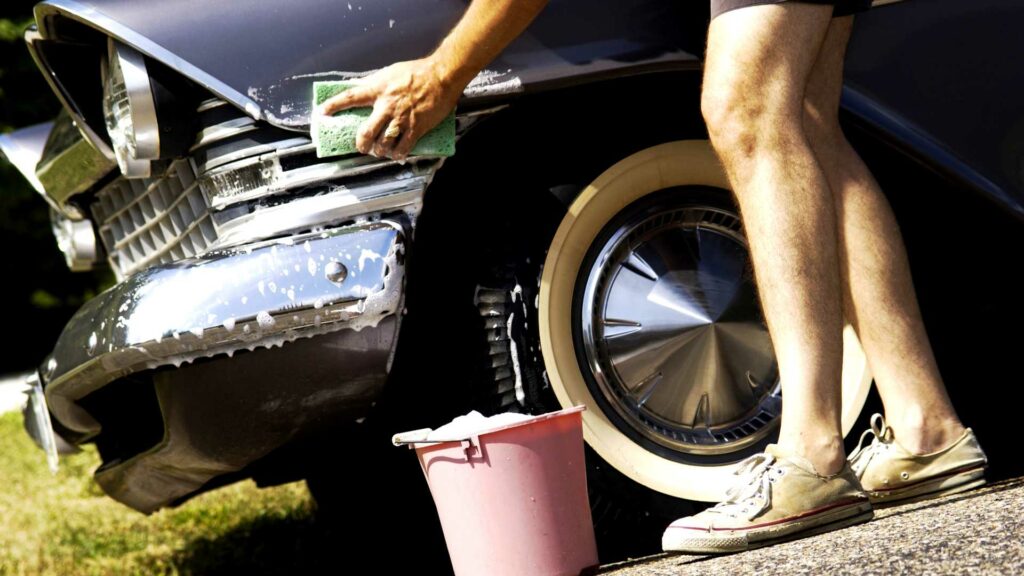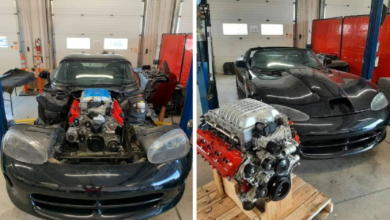How To Clean A Classic Car With The Most Effective Tips
Classic cars always have a very unique attraction for car lovers. So owning and driving them on the road is a great feeling. But besides that, in order to keep the beauty of the car, it is necessary to have a suitable cleaning method.
You certainly already know not to wash your car at drive-in facilities, but you may not know all the other suggestions for washing vintage cars. Any antique car owner should be aware of these regulations. Proper car cleaning will keep your car in top condition, prevent damage and maintain its value. Therefore this article was born to bring you How To Clean A Classic Car With The Most Effective Tips.
Let’s get started!
Why Is How To Clean A Classic Car Different?

Classic cars require meticulous cleaning with specialized materials, as opposed to modern cars. Your car can experience hard-to-repair and expensive replacement if you clean it with the wrong equipment or products. You’ll also need to make sure you’re taking extra precautions when drying to avoid rust damage as older cars are more likely to experience rust problems.
If you regularly drive a car, you should wash it about once a week, a little more often than the recommended two-week interval for a typical car. Cleaning your vintage car is much more important than cleaning a regular car as it has a much higher value and can lose that value if impurities such as dirt or insects are allowed to accumulate. outside.
What Preparation Is Needed To Clean A Classic Car?
Before learning about how to clean a classic car, you must have all the supplies you need to thoroughly clean your car. To prepare to wash your classic car, follow these easy steps: :
- Making sure you have the proper cleaning supplies is the first step to a safe and effective car wash. To get started, you’ll need a sheepskin or cotton chenille washcloth or glove to clean the exterior of your car. Compared to a sponge or brush, these tools offer more speed and convenience, and their soft, high-quality material won’t leave any stains on the surface. At the end of the car wash, you’ll also need a soft leather towel or soft microfiber towel to dry the car, as regular hand towels can scratch the surface.
- Next, you should choose the right soap. Do not use dish soap or cheap detergents to wash your car. Instead, use a high-quality car wash soap, such as Turtle Wax. Abrasives will wear down the paint on your car, so make sure the cleaner you use doesn’t include any cleaners.
- Finally, a set of clay bars can be useful if you want to protect your car’s paint finish from pollutants and airborne contaminants that regular hand washing and waxing won’t be able to remove.
You should be fully equipped to clean the exterior of your car with specialized goods such as the machines mentioned above.
Depending on the material of the seats and other interior components of the car, different cleaning materials will be required to clean a classic car.
How To Clean A Classic Car (Outside Of Car)

Now that you have everything you need to wash your car, you can start doing it safely and efficiently. Here are some suggestions for how to clean a classic car:
Just wash by hand:
This is the first tip on how to clean a classic car. Be careful when driving your vintage car near machinery. You probably won’t get a thorough cleaning. Furthermore, your vehicle may be damaged by your actions. To keep your car in pristine condition, hand wash with sheepskin or cotton chenille gloves. You can use a toothbrush with soft bristles if you cannot easily reach specific areas with your hands.
Maintain cleaning in the shade:
Unlike drivers, cars don’t like sunbathing, especially once cleaned. Sunlight can cause soap to quickly evaporate, leaving stains and stains on the paint.
Wash from top to bottom:
Another tip on how to clean a classic car. This is directly related to one of the fundamental laws of our universe: gravity. If you clean your car from the bottom up, dirt and other impurities will land on clean areas as you go. Also, starting from the bottom can result in you spreading abrasive metal debris and brake fluid from the brake system to the entire vehicle if you only use one towel or towel.
Choose the right soap:
While regular dish soap can clean your car, it will also tarnish the paint and make it look “worn”. It will reduce the value of your car and make it less attractive. Use a specially formulated, non-abrasive car wash soap to keep your car looking like new instead of investing money and time repainting it after a shower. Here’s a tip to keep in mind on how to clean a vintage car
Clean your wheels last:
After you’ve cleaned your car’s paint using classic car cleaning tips, it’s time to focus on the wheels, the dirtiest part of your car. It is recommended to use fresh towels or washcloths for the best cleaning results as they will accumulate more than in other places.
Wash:
After you have properly cleaned your car according to how to clean a classic car, rinse it with a steady stream of water. Try not to use more water than necessary. Water abuse can stagnate in hard-to-reach places, which can damage metal by rusting.
Dry it completely:
Water may seem innocent but it actually contains small minerals that will create stains on your car. Use a special towel to dry the car from the top down to avoid these stains from damaging the paint job. To prevent rust, make sure you’re drying everything, even the hardest spots. Don’t dry the wheels and tires until the last minute as they will still be oily after washing and you don’t want to risk getting any grease stains on the rest of the car. Tips to keep in mind in how to clean a classic car
Using a stick of clay:
In how to clean a classic car, if you notice that your car’s paint is rough after washing and drying, you can use a clay bar to smooth it out and remove any hard-to-remove dirt like road salts. Just remember to spray the detail lubricant on the paint before rubbing it with the clay stick.
Apply protective wax regularly:
Even if you don’t need to wax your car every time you wash your car, if you drive often, you should plan to wax your car every six to eight weeks. Your car’s paint will be shielded from agents and UV rays by waxing, keeping your car as shiny as the day it was bought. You should wax your car in the shade, similar to how you wash your car, as wax can stain hot paint.
Clean your chrome:
A good tip of how to clean a classic car. If your car contains chrome, you should take proactive steps to keep it looking great. When you wash your car, look for a high-quality chrome polish to put it on.
Apply tire moisturizer
Apply tire conditioner to your tires after cleaning and let them dry completely if you want to prevent premature tire damage and aging. This extra step will protect your tires and give them a glossy, jet-black look.
How To Clean A Classic Car (Inside Of Car)

Glass and windows:
While Windex can be great for home windows, it won’t effectively clean the glass in your car. To keep your windows from staining, you’ll need to use a more specialized car glass cleaner.
Dust:
The dust on your dashboard is right in front of you, but you can easily remove it with a vacuuming microfiber towel which is the ideal tool for dusting your antique car.
Carpet:
Start by combing and vacuuming the carpet. The next step of how to clean a classic car is to use a foaming cleaner to clean your carpet, about one square foot at a time. Then vacuum again to remove any remaining vacuum cleaner debris. You can even use compressed air to blow piles of carpet up and out. Finally, let the carpet air dry before using your car.
Carpet:
Start by combing and vacuuming the carpet. Next step
of how to clean a classic carl is to use a foaming cleaner to clean your carpet, about one square foot at a time. Then vacuum again to remove any remaining vacuum cleaner debris. Even compressed air can be used to blast toss the carpet up and beyond. Finally, let the carpet air dry before using your car.
Woven surface:
You can start cleaning fabric seats the same way you would with plastic and leather by vacuuming your car in how to clean a classic car. Standard vacuum attachments can be used. Use a side cleaner to remove stains and maintain fabric cleanliness. While there are three types of cleaners allowed – volatile, synthetic and non-alkaline cleaners – volatile cleaners are the best choice for cleaning antique cars.
Synthetic cleaners remove stains effectively, but they can detract from the fabric’s aesthetic. Neutral soaps are also less effective. Volatile detergents, on the other hand, are highly solvable and retain the color of the fabric. Use one specifically for car washes. Let the area dry after using the cleaner and cleaning the stain, then vacuum again.
Convertible vinyl and tops:
With warm water, a neutral milk-absorbing soap, and a soft-bristled brush, you should clean convertibles. If your car still needs cleaning after you scrub, apply a mild foaming cleaner, being careful not to let it stick to the bodywork. Finally, dry the head thoroughly after rinsing. When the top is still damp, lowering it into the car body can lead to mold or unsightly wrinkles.
Materials for polyurethane foam:
You can use a solution of laundry detergent and water to clean the residue on any polyurethane trim in your car. Apply the cleaning solution to the affected area of the polyurethane if it has been soiled with grease or sealant so that the stains are still there to dislodge the dirt. Then, using a cloth that has been dipped in volatile detergent and wrung dry, you can clean it. Apply the cream again, then rinse with clean water and a sponge to complete the process.
Conclusion
Now you know the tips on how to clean a classic car to get the best results. Classic cars need a lot of care and maintenance because chugs are very susceptible to damage and deterioration. So have a reasonable care and maintenance plan. Follow more articles about classic cars at our website




